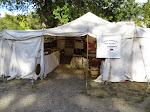“I like your costume.”
I hear this frequently, and every time I do, I cringe. Costumes, in my mind, conjure up images of Halloween and cheap costumes worn over clothing and fastened with ties or Velcro. The clothing that I wear is more than just a costume. My wardrobe is carefully researched, and the fabrics and buttons chosen to be in keeping with original period-appropriate clothing.
My Civil War dresses are collar-less and have dropped sleeves. My camp dresses, which date to an earlier era, have collars, and are shapeless. I also have a bloomer outfit which was sewn from a picture of Mary Edwards Walker.
Under my dresses are period type undergarments. My petticoats are muslin, reinforced with rope. I may, or may not be wearing a hoop skirt. In the winter I wear a double flannel petticoat, which keeps my lower half toasty warm. My chemise serves a couple of different purposes. It is long enough to keep me modest if I should fall with a hoop skirt on, and it provides comfort underneath my corset. My corset is a working corset. It is comfortable (except in hot weather) and provides good back support. Last, but not least, are my pantalettes, mid-calf length with lace and eyelet trim. If I dress as a 19th century woman I want to make sure that I am as accurate as possible so that I can experience the time period fully, right down to my skivies.
My shoes have been hand-made to fit my feet. Black in color with square toes, they are made of leather with nailed on soles. My stockings are standard sutler issue: striped and thigh high. I wear my hair parted down the middle and pulled back in a bun. The bun is covered by a black beaded, crocheted hair piece. My watch is a pin-on type, which hangs from a chatelaine. Depending on the season, I might be wearing a shawl or a peletot coat. A bonnet or hat may also be worn.
Some period items are hard to find. It was much easier 150 years ago. Today you consider yourself lucky to find someone who makes reproduction items. The alternative is to scour auctions, yard sales and on-line websites to find originals in good shape. Either way it is time consuming and costly.
Costume? Living historians don’t play dress up. We take it very seriously, sometimes to the point of wearing our hair or facial hair (for the men) or spectacles in 19th century styles all of the time. We pay attention to the details that no one else sees. When we are at events (reenactments) the spectators are the ones who are dressed funny. I think the next time someone tells me that they like my costume I will reply with, “Thanks. I like your costume, too!”


Ahhh I love it!!
ReplyDelete